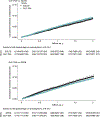Glucagon-Like Peptide-1 Receptor Agonists and Risk for Depression in Older Adults With Type 2 Diabetes : A Target Trial Emulation Study
- PMID: 39993315
- PMCID: PMC12132804
- DOI: 10.7326/ANNALS-24-01347
Glucagon-Like Peptide-1 Receptor Agonists and Risk for Depression in Older Adults With Type 2 Diabetes : A Target Trial Emulation Study
Abstract
Background: Although glucagon-like peptide-1 receptor agonists (GLP-1RAs) have shown potential antidepressant effects, population studies yield inconsistent results.
Objective: To compare the risk for depression in older adults with type 2 diabetes (T2D) initiating treatment with GLP-1RAs versus sodium-glucose cotransporter-2 inhibitors (SGLT2is) or dipeptidyl peptidase-4 inhibitors (DPP4is).
Design: Target trial emulation study.
Setting: U.S. National Medicare administrative data from January 2014 to December 2020.
Patients: Adults aged 66 years or older with T2D initiating treatment with a GLP-1RA were matched 1:1 on propensity score with those initiating treatment with either an SGLT2i or a DPP4i.
Measurements: The primary end point was incident depression. Cox proportional hazards regression models were used to estimate the hazard ratio (HR) with 95% CI within matched groups.
Results: A total of 14 665 matched pairs of older adults were included in the cohort for GLP-1RAs versus SGLT2is; the rate difference of depression between GLP-1RA users and SGLT2i users was 3.48 (95% CI, -0.81 to 7.78) per 1000 person-years, with an HR of 1.07 (CI, 0.98 to 1.18). In the cohort for GLP-1RAs versus DPP4is (13 711 matched pairs), the rate difference was -5.78 (CI, -10.49 to -1.07) per 1000 person-years, with an HR of 0.90 (CI, 0.82 to 0.98).
Limitation: Unmeasured confounders (such as hemoglobin A1c levels and body mass index), outcome misclassification, and limited generalizability to all GLP-1RA users (for example, younger populations or those without T2D receiving the drug for obesity treatment).
Conclusion: Among older adults with T2D, the incidence of depression was relatively low. Use of GLP-1RAs was associated with a modestly lower risk for depression compared with use of DPP4is, but not SGLT2is.
Primary funding source: National Institute of Diabetes and Digestive and Kidney Diseases of the National Institutes of Health.
Conflict of interest statement
Figures



References
-
- U.S. Centers for Disease Control and Prevention. National Diabetes Statistics Report. 15 May 2024. Accessed at www.cdc.gov/diabetes/php/data-research/index.html on 7 June 2024.
MeSH terms
Substances
Grants and funding
LinkOut - more resources
Full Text Sources
Medical
